KAHIKO ARTS WORKSHOPS I
The World Was Tied Together
Creating cordage from different
plant fibers
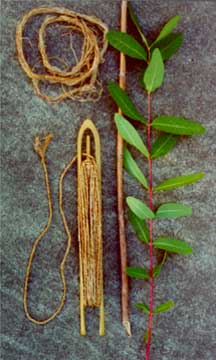
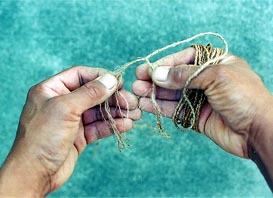 The
ability to twine, braid, twist, roll or weave fibers into cordage
is one of the oldest of mankind's primitive skills. The materials
from which to ply and braid cords or ropes are in abundance everywhere.
Any fibrous material that has reasonable length, moderate strength
and is flexible or pliable can be utilized.
The
ability to twine, braid, twist, roll or weave fibers into cordage
is one of the oldest of mankind's primitive skills. The materials
from which to ply and braid cords or ropes are in abundance everywhere.
Any fibrous material that has reasonable length, moderate strength
and is flexible or pliable can be utilized.
Lashing dwellings, making mats, containers, clothing,
snares, fishnets, hammocks and bow strings are a few of the uses
of cordage. Lacking nails, bolts and screws, and having little
to use for adhesives, indigenous cultures tied their world together.
In the class we will talk about the extraction and
preparation of various plant fibers. Techniques of plying the
fibers into cordage will then be explored. Also, the efficient
method of leg rolling cordage in one direction will be practiced.
Cordage will be made from dogbane, tule (bulrush), cattail and
New Zealand flax.
The Art of Calling Down the
Sun
Various methods of creating fire
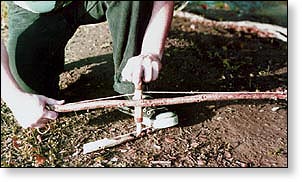
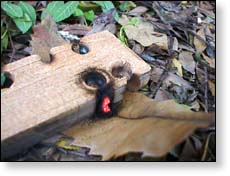
Fire was considered sacred because it was so essential
for the welfare of humans. Fire was necessary for survival. It 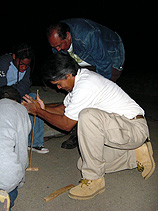 provided warmth, protection, cooked and
preserved food, a means to shape weapons and tools, furnished
light and boiled water.
provided warmth, protection, cooked and
preserved food, a means to shape weapons and tools, furnished
light and boiled water.
There are several methods for starting a fire. We
will cover and demonstrate the various techniques of fire by friction
(fire pump, fire saw, fire plow, bow drill and hand drill), as
well as fire by percussion (flint and steel) and compression (fire
piston).
There will be hands-on activities using the hand drill
and the bow drill. We will also construct a tinder bundle and
start a fire. Identifying various local plant materials for fire
making will be discussed.
Wet Scrape Brain Tanning
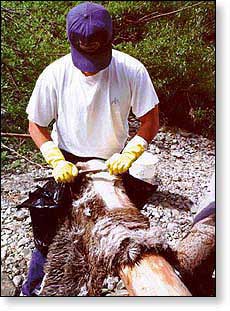
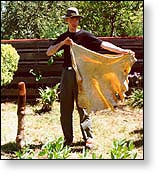 Before the development of textiles, aboriginal cultures
around the world depended on the making of leather for clothing
and other goods in their daily lives.
Before the development of textiles, aboriginal cultures
around the world depended on the making of leather for clothing
and other goods in their daily lives.
We'll be teaching a way of tanning that is known as
wet scrape brain tanning. The procedure transforms a deer hide
into a soft and washable piece of leather, without the use of
any chemical or toxic products. Nature provides all of the necessary
ingredients for this type of tanning.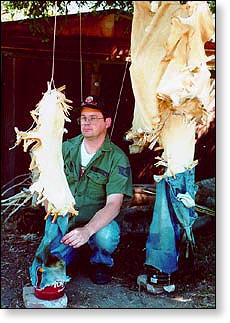
You will experience the whole process of scraping
and stretching the hide to smoking the softened buckskin. Four
students will be assigned to one hide and each person will walk
away with 1/4 of a brain tanned buckskin.
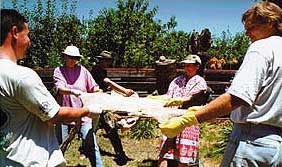
Making a Tree Fly
Arrow making
Historians suggest that early man progressed
from stone throwing to an atlatl, then to the bow and arrow. This
latter invention was an integral part of most cultures around
the world. The bow and arrow bears witness to the fact that we
have a common heritage as hunters and gatherers. In the workshop,
we will deal with the mate of the hunter's bow . . . the lightning
stick.
The basic parts of an arrow are the nock, fletching,
shaft, foreshaft (if it has one) and point. We will create a functional
arrow utilizing natural, raw materials. The points will be made
of obsidian, as well as other natural resources. Due to the limited
time, the obsidian points will already be knapped.

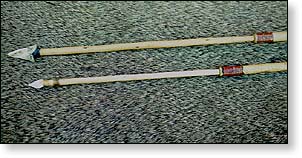
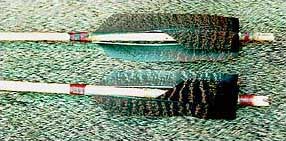
© KAHIKO Arts 2017
No part, content, graphic, illustration or photo from this
webpage may be copied, transferred or reproduced without express written permission
from KAHIKO
Arts. Contact Dino Labiste at KahikoArts@yahoo.com.